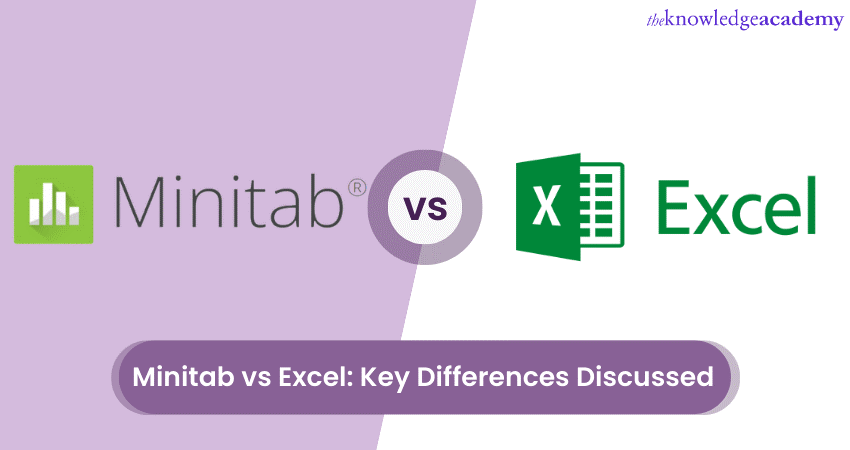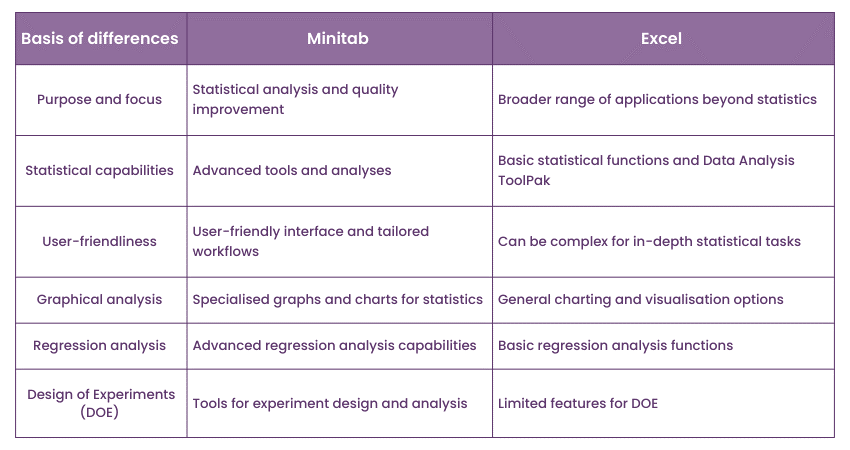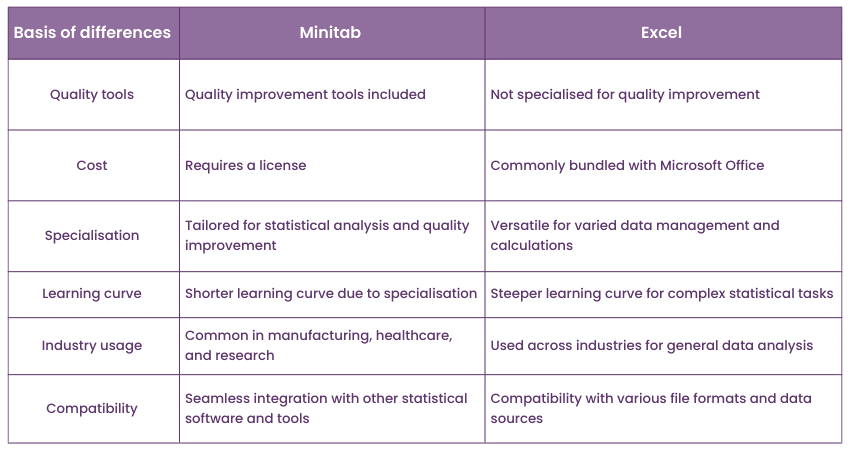We may not have the course you’re looking for. If you enquire or give us a call on 01344203999 and speak to our training experts, we may still be able to help with your training requirements.
Training Outcomes Within Your Budget!
We ensure quality, budget-alignment, and timely delivery by our expert instructors.

In the world of statistical software and data analysis, there are two popular tools that offer a range of capabilities. While selecting one particular software for the organisation, however, a common question arises in the heads of those charged with the choice: Minitab vs Excel.
While Minitab has witnessed a quick rise to the top of the market, Microsoft Excel is one of the primary statistical software, a true innovator that transformed the field of data analysis. This can be backed up by numbers from Micro Biz Mag, which clearly state that as of 2023, Excel has almost 1.1 billion users worldwide.
This blog will discuss the distinctions of Minitab vs Excel, discussing the key features of both in detail and help you choose a tool based on your business needs.
Table of Contents
1) What is Minitab? What are its features?
2) What is Microsoft Excel? What are its features?
3) Key difference between Minitab and Excel
4) Minitab vs Excel: Which tool to choose?
5) Conclusion
What is Minitab? What are its features?
Minitab is a robust statistical software and analysis package that is widely used by researchers, statisticians, and quality improvement professionals. It provides a comprehensive set of tools for data analysis, graphical representation, regression analysis, design of experiments, and quality control. Minitab is known for its user-friendly interface and robust statistical capabilities.

Features of Minitab
The key features of Minitab can be listed as follows:
a) Statistical analysis: Minitab provides a wide range of statistical tests and analyses, including t-tests, ANOVA, regression analysis, and chi-square tests. It offers a comprehensive suite of statistical tools for both basic and advanced calculations.
b) Graphical analysis: Minitab allows users to create various types of graphs and charts, such as histograms, scatterplots, boxplots, and control charts. These graphical representations help in visualising data patterns and relationships.
c) Regression analysis: Minitab offers advanced regression analysis capabilities, allowing users to model and analyse complex relationships between variables.
d) Design of Experiments (DOE): Minitab provides tools for designing and analysing experiments, enabling users to optimise processes and identify critical factors affecting the outcome.
e) Quality tools: Minitab includes a range of quality improvement tools, such as Pareto charts, fishbone diagrams, and process capability analysis. These tools help in identifying and eliminating process variations and improving overall quality.
What is Microsoft Excel? What are its features?
Excel, developed by Microsoft, is a spreadsheet program that is used for various purposes, including data organisation, calculation, visualisation, and fundamental statistical analysis. It is a versatile tool that is widely used in businesses, academia, and personal projects. Excel offers a distinct range of functions and features, making it a popular choice for data manipulation and visualisation.
Features of Excel
The key features of Microsoft Excel can be listed as follows:
a) Basic mathematical operations: Excel offers a wide range of mathematical functions for performing basic calculations and operations on data.
b) Data organisation and manipulation: Excel provides a spreadsheet interface that allows users to organise and manipulate data efficiently. It offers features like sorting, filtering, and data validation.
c) Charting and visualisation: Excel allows users to create various types of charts and graphs, making it easy to visualise data and trends.
d) Basic statistical functions: Excel includes basic statistical functions, such as mean, median, standard deviation, and correlation coefficient. These functions enable users to perform simple statistical analyses.
e) Data Analysis ToolPak: Excel's Data Analysis ToolPak is an add-in that provides additional statistical analysis tools, such as regression analysis, t-tests, and ANOVA.
Master advanced functionalities, and become an Excel expert with our comprehensive Microsoft Excel Masterclass training. Register now!
Key difference between Minitab and Excel
Listed below are the key differences between Minitab and Excel:

a) Purpose and focus: Minitab is specifically designed for statistical analysis and quality improvement, while Excel has a broader range of applications beyond statistical analysis.
b) Statistical capabilities: Minitab offers a comprehensive suite of advanced statistical tools and analyses, while Excel provides basic statistical functions and the Data Analysis ToolPak for more straightforward analyses.
c) User-friendliness: Minitab has a user-friendly interface with intuitive workflows tailored for statistical analysis, while Excel can be more complex for in-depth statistical tasks.
d) Graphical analysis: Minitab excels in graphical analysis, allowing users to create various types of graphs and charts designed explicitly for statistical representation, while Excel offers more general charting and visualisation options.
e) Regression analysis: Minitab offers advanced regression analysis capabilities, enabling users to model and analyse complex relationships between variables, whereas Excel provides basic regression analysis functions.
f) Design of Experiments (DOE): Minitab includes tools for designing and analysing experiments, optimising processes, and identifying key factors affecting outcomes, while Excel lacks specialised features for DOE.

g) Quality tools: Minitab integrates quality improvement tools such as Pareto charts, fishbone diagrams, and process capability analysis, which are not readily available in Excel.
h) Cost: Minitab is a commercial software that requires a license, whereas Excel is commonly bundled with Microsoft Office and is more widely accessible.
i) Specialisation: Minitab is tailored specifically for statistical analysis and quality improvement, making it ideal for researchers, statisticians, and quality professionals, whereas Excel caters to a broader audience with varied data management and calculation needs.
j) Learning curve: Minitab has a shorter learning curve due to its specialised nature, while Excel's versatility can result in steeper learning curves for complex statistical tasks.
k) Industry usage: Minitab is often preferred in industries such as manufacturing, healthcare, and research, where advanced statistical analysis and quality improvement are crucial, while Excel is commonly used across industries for general data manipulation and analysis.
l) Compatibility: Minitab allows for seamless integration with other statistical software and tools, while Excel offers compatibility with various file formats and data sources.
Minitab vs Excel: Which tool to choose?
When deciding between Minitab and Excel, consider the following pointers to choose the most appropriate tool for your needs:
a) Type of analysis: If your primary focus is on statistical analysis, regression modelling, design of experiments, or quality improvement, Minitab is the recommended choice due to its specialised tools and comprehensive statistical capabilities. However, Excel can suffice if you require a tool for general data manipulation, organisation, and fundamental statistical analysis.
b) Comfort level: Consider your comfort level with statistical software and your familiarity with each tool's interface. Minitab is known for its user-friendly interface and intuitive workflows, making learning and navigating for statistical analysis tasks easier. Conversely, Excel may have a steeper learning curve for complex statistical tasks, but its familiarity and versatility can benefit users already proficient with the tool.
c) Depth of analysis: Assess the complexity of your analytical tasks. Minitab offers advanced statistical analyses, specialised graphing capabilities, and tools for quality improvement, making it ideal for researchers, statisticians, and professionals engaged in in-depth data analysis. While providing basic statistical functions and the Data Analysis ToolPak, Excel may be better suited for more straightforward statistical analyses or when a more general-purpose tool is required.
d) Industry consideration: Consider the industry in which you work or the specific requirements of your project. Minitab is commonly used in industries such as manufacturing, healthcare, and research, where advanced statistical analysis and quality improvement are paramount. Excel, being widely used across industries, can be suitable when statistical analysis is just one aspect of your overall data management and analysis needs.
e) Cost and accessibility: Evaluate the financial aspect of acquiring the software. Minitab is a commercial software that requires a license, and the cost may vary based on the type of license and usage. Excel, on the other hand, is often bundled with Microsoft Office, making it more readily accessible and cost-effective for many users.
f) Integration and compatibility: Consider the need for integration with other tools or compatibility with specific file formats or data sources. Minitab offers seamless integration with other statistical software and tools, allowing for a smoother workflow. Excel, on the other hand, is known for its compatibility with various file formats, making it easier to work with data from different sources.
Master Microsoft Excel, excel in data analysis and management with our comprehensive Microsoft Excel Training & Certification Course! Register now!
Conclusion
To sum up, Minitab and Excel are two powerful tools with distinctive features and capabilities. Minitab excels in statistical analysis and quality improvement, offering a comprehensive suite of specialised tools. Excel, similarly, is a versatile tool widely used for various data-related tasks beyond statistical analysis.
By understanding the key differences of Minitab vs Excel outlined in this blog, you can make an informed decision based on your specific business needs, maximising productivity and efficiency.
Improve your business reporting and key analytical skills to meet organisational needs. Sign up for Business Intelligence Reporting training today!
Frequently Asked Questions
Upcoming Office Applications Resources Batches & Dates
Date
 Microsoft Power BI Course
Microsoft Power BI Course
Wed 15th May 2024
Wed 5th Jun 2024
Wed 19th Jun 2024
Wed 3rd Jul 2024
Wed 17th Jul 2024
Wed 7th Aug 2024
Wed 21st Aug 2024
Wed 4th Sep 2024
Wed 18th Sep 2024
Wed 9th Oct 2024
Wed 23rd Oct 2024
Wed 6th Nov 2024
Wed 20th Nov 2024
Wed 4th Dec 2024
Wed 11th Dec 2024
Wed 18th Dec 2024







 Top Rated Course
Top Rated Course


 If you wish to make any changes to your course, please
If you wish to make any changes to your course, please


